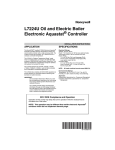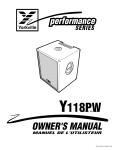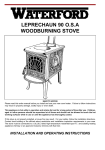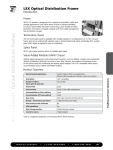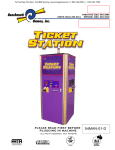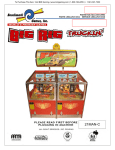Download EC-10 Installation Operating Instructions-English
Transcript
EUTECTIC EC-10 OIL-FIRED WATER BOILERS/NO. 2 OIL INSTALLATION AND OPERATING INSTRUCTIONS SAFETY WARNING: KEEP BOILER AREA CLEAR AND FREE FROM COMBUSTIBLE MATERIALS, GASOLINE AND OTHER FLAMMABLE VAPORS AND LIQUIDS. FAILURE TO ADHERE TO ABOVE SAFETY WARNING, MAY RESULT IN PERSONAL INJURY OR DEATH AND PROPERTY DAMAGE. CONTENTS . . . . . . . . . . . . . . . . . . . . . . . . . . . . . . . . . . . .PAGE Ratings and Dimensions . . . . . . . . . . . . . . . . . . . . . . . . . . . . .2 Installation Requirements: Boiler Location . . . . . . . . . . . . . . . . . . . . . . . . . . . . . . . . . . .3 Clearances . . . . . . . . . . . . . . . . . . . . . . . . . . . . . . . . . .3 & 4 Chimney Requirements . . . . . . . . . . . . . . . . . . . . . . . . . . . .3 Air Supply and Venting . . . . . . . . . . . . . . . . . . . . . . . . . . .3-7 Controls and Accessories . . . . . . . . . . . . . . . . . . . . . . . . . .7 Piping for Water Units . . . . . . . . . . . . . . . . . . . . . . . . . . . . .7 Installing Burner . . . . . . . . . . . . . . . . . . . . . . . . . . . . . . . . .8 Oil Supply Piping . . . . . . . . . . . . . . . . . . . . . . . . . . . . . . . . .8 Wiring the Boiler . . . . . . . . . . . . . . . . . . . . . . . . . . . . . . . . .8 Vent Piping and Draft Regulator . . . . . . . . . . . . . . . . . . . . .8 Operating Instructions: Precautions Before Starting . . . . . . . . . . . . . . . . . . . . . . . .8 Start-up . . . . . . . . . . . . . . . . . . . . . . . . . . . . . . . . . . . . . . . .8 Cleaning and Filling New Water Boiler . . . . . . . . . . . . . . . .9 Care and Maintenance: Extended Shutdown . . . . . . . . . . . . . . . . . . . . . . . . . . . . . .9 Freezing Protection . . . . . . . . . . . . . . . . . . . . . . . . . . . . . .10 Oil Burner . . . . . . . . . . . . . . . . . . . . . . . . . . . . . . . . . . . . . .10 General Maintenance . . . . . . . . . . . . . . . . . . . . . . . . . . . .10 Wiring Diagrams . . . . . . . . . . . . . . . . . . . . . . . . . . . . . . . .11-13 Burner Data . . . . . . . . . . . . . . . . . . . . . . . . . . . . . . . . . . . .14-17 Appendix A–G . . . . . . . . . . . . . . . . . . . . . . . . . . . . . . . . .18-20 IMPORTANT: The installation of this equipment must conform to the requirements of the authority having jurisdiction or, in the absence of such requirements, to the Installation of Oil Burning Equipment, CSA B139, latest edition. The installation must also conform to the additional requirements in this Slant/Fin Instruction Manual. Where there is any difference, the more stringent requirement shall govern. In addition, where required by the authority having jurisdiction, the installation must conform to American Society of Mechanical Engineers Safety Code for Controls and Safety Devices for Automatically Fired Boilers, No. CSD-1 or CSA B149.1-00 for natural gas and propane. If there is any conflict in the above requirements, then the more stringent requirement will apply. SERVICE COMPANY Name_______________________________________________ Address _____________________________________________ ____________________________________________________ Telephone ___________________________________________ THIS MANUAL MUST BE LEFT WITH OWNER AND SHOULD BE HUNG ON OR ADJACENT TO THE BOILER FOR REFERENCE. IMPORTANT: This boiler must be installed, serviced and repaired by a trained, experienced, service technician, licensed for the installation and servicing of oil burning hot water heating system equipment or otherwise qualified by the authorities having jurisdiction over the installation. Model #_____________________________________________ Serial # _____________________________________________ Printed in Canada 6/10 Part No. 470900000 Publication No. EC-10-40 Rev. C A Rev. EUTECTIC EC-10 2 Figure 1: Dimensions 355mm (13-3/32) 195mm (7-11/16) Relief valve 19mm (3/4") 835mm (32-7/8") 32mm (1-1/4") threaded supply 289mm (1-1/8) 113mm (4-7/16) 79mm (11-3/8) 394mm(15-1/2) 60mm (2-23/64) 32mm (1-1/4) threaded return pipe 156mm (6-9/64") 138mm(5-7/16) ∅ 110mm (4-21/64) hole ∅ 130mm (6-7/64) cut-out 563mm(22-11/64) (4) 3/8-16 studs on ∅ 6-29/32 4 markings on ∅ 176mm (6-15/16) 285mm (11-7/32) 163mm (6-27/64) 570mm (22-7/16) 570mm (22-7/16) Note: Add 203mm (8") to B dimensions to allow for Riello burner TABLE 1: Ratings and Dimensions OIL INPUT † § GROSS OUTPUT* NET OUTPUT* CHIMNEY SIZE I.D. ROUND I.D. ROUND X HEIGHT mL/s GPH Watts BTU/H kW MBH kW MBH EC-13A 0.68 0.65 26,672 91,000 23 79 20 69 152 x 4.6 6 x 15 EC-13B 0.74 0.70 28,724 98,000 25 85 22 74 152 x 4.6 6 x 15 . AFUE % BOILER MODEL NO. mm x m (in X ft.) APPROX. OVERALL LENGTH BOILER LENGTH "A" DIMENSIONS BOILER LENGTH "B" . FLUE DIA "C" FLUE DISTANCE BETWEEN OUTLET LEGS LENGTH "D" "E" "F" mm in mm in. mm in. mm (in.) mm in. mm 87 914 36 25 22-1/4 686 27 127 5 300 11-13/16 51 in. 2 86 914 36 25 22-1/4 686 27 127 5 300 11-13/16 51 2 EC-14A 0.84 0.80 32,827 112,000 29 98 25 85 152 x 4.6 6 x 15 87 1041 41 686 27 813 32 127 5 427 16-13/16 51 2 EC-14B 0.95 0.90 36,931 126,000 32 109 28 95 152 x 4.6 6 x 15 86 1041 41 686 27 813 32 127 5 427 16-13/16 51 2 EC-15A 1.05 1.00 41,034 140,000 36 123 31 107 152 x 4.6 6 x 15 87 1168 46 819 32-1/4 940 37 127 5 554 21-13/16 51 2 EC-15B 1.16 1.10 45,137 154,000 39 134 34 117 152 x 4.6 6 x 15 86 1168 46 819 32-1/4 940 37 127 5 554 21-13/16 51 2 EC-16A 1.21 1.15 47,189 161,000 41 141 36 123 152 x 4.6 6 x 15 87 1295 51 946 37-1/4 1067 42 152 6 681 26-13/16 102 4 EC-16B 1.32 1.25 51,293 175,000 45 152 39 132 152 x 4.6 6 x 15 86 1295 51 946 37-1/4 1067 42 152 6 681 26-13/16 102 4 Maximum operating pressure 414 kPa (60 psi). All boilers hydrostatically tested — A.S.M.E. * For forced hot water heating systems where the boiler and all piping are located within the area to be heated, the boiler may be selected on the basis of net capacity output. The net output ratings shown are based on an allowance for piping and pickup of 1.15 (water). Gross capacity output is divided by the allowance to obtain net rating. The Slant/Fin Technical Service department should be consulted before selecting a boiler for unusual piping and pickup requirements such as intermittent system operation, extensive piping, etc. † Ratings apply to the use of light oil at 11 000 W/L (140,000 Btu per gallon) and apply only when burner models listed on pages 13 and 16 of this manual are used, and are properly adjusted to produce 13% CO2. § Boiler models have two firing rates. The boiler is factory shipped at the lower firing rate. To obtain the higher firing rate, refer to the boiler installation instructions for the appropriate field adjustments. # All dimensions subject to normal manufacturing tolerance. NOTE: All boilers under 87.9 kW (300,000 Btuh) input are tested and certified for A.F.U.E. capacities. EUTECTIC EC-10 3 THE INSTALLATION INSTRUCTIONS IN THIS MANUAL ARE ABBREVIATED. SEE THE FRONT COVER OF THIS MANUAL FOR REFERENCES TO CODES AND STANDARDS. BOILER LOCATION CAUTION: NEVER BURN GARBAGE OR PAPER IN THE UNIT, AND NEVER LEAVE COMBUSTIBLE MATERIAL AROUND IT. Provide a level, solid foundation for the boiler. Location should be near the chimney so that the Flue Pipe Connector or Breeching to the chimney is short and direct. A. The foundation must be capable of supporting the weight of the boiler when filled with water: Boiler Size EC-13 EC-14 EC-15 EC-16 Approximate Total Weight of Boiler Assembly*, filled with water kg lbs 160 353 193 426 227 501 261 575 * Includes burner, circulator and controls B. The EC-10 Boiler has full wet base sections which surround fire-box for maximum heat absorption of burning fuel, and low floor temperature. C. If boiler is to be located over buried conduit containing electric wires or telephone cables, consult local codes or the National Board of Fire Underwriters for specific requirements. MINIMUM CLEARANCE Provide accessibility clearance of 610mm (24") from surfaces requiring servicing (top and front) and 508mm (20") on any side requiring passage. The boiler shall be installed with the following MINIMUM clearances from combustible materials: A. CHIMNEY CONNECTOR- 457mm (18") B. BACK AND SIDES- 152mm (6") EXCEPT as limited by 457mm (18") clearance from chimney connector NOTE: Except in closets and alcoves, clearances above in (A) and (B) may be reduced by providing forms of protection as specified in NFPA 31, latest edition. See bottom of page 4 for clearance diagrams. CHIMNEY REQUIREMENTS (see CSA B139, latest edition, section 7) A. The chimney must be constructed in accordance with all local applicable codes and the National Board of Fire Underwriters. See boiler models and rating table shown on page 2 for chimney sizes. B. Check chimney condition. Existing chimneys and stacks may have deteriorated; without repairs their use would be hazardous. Before connecting to an old chimney or stack: 1. Clean it. 2. Inspect it thoroughly. 3. Remove obstructions. 4. Replace worn sections of metal stacks. 5. Seal bad masonry joints. 6. Repair damaged lining. C. Breeching area must not be reduced at connection into chimney. Breeching must be inserted into, but not beyond, inside of chimney liner. D. Chimney height shall extend at least .914m (3 feet) above where it passes through the roof of the building, and at least .610m (2 feet) above any ridge within 3.05m (10 feet) of the chimney. E. The use of a vent cap, where permitted by code, gives additional protection against adverse wind conditions and precipitation. F. Flue Connection: Connect flue pipe between top of boiler and chimney. Horizontal sections of flue pipe must be pitched upward to the chimney at least 20mm/m (1/4" per foot). Flue must be inserted into, but not extend beyond, the inside wall of the chimney flue. Draft regulator is not required but may be installed if conditions warrant it. Install draft regulator in flue pipe, as shown in figure 2. CAUTION: AN OIL-FIRED UNIT SHALL BE CONNECTED TO A VENT HAVING SUFFICIENT DRAFT AT ALL TIMES TO ENSURE SAFE AND PROPER OPERATION OF THE UNIT. AIR SUPPLY AND VENTILATION (see CSA B139, latest edition, Section 7) Sufficient air for combustion and ventilation in the boiler room must be provided. Failure to do this will result in poor combustion, heavy sooting and health hazards. Any oil-fired boiler must have a steady draft* and an ample supply of combustion air at all times during firing. If air supply or chimney draft* is unreliable, CO and overfire draft* will change unpredictably. 2 DO NOT vent this boiler to the same chimney flue used by a fireplace or coal or wood burning furnace or boiler. The draft* produced by solid fueled devices varies tremendously between high fire and low fire: (continued on page 5) EUTECTTC EC-lO PITCH UP 2omm/m (1/4" PER LTNEAR FOOT) PITCH UP 2omm/m (1/4" PER LTNEAR FOOT) DRILL 6mm (1/4) HOLE rO MEASURE DRAFI, SMOKE, CO2 % AND DRILL 6mm (1/4') HOLE MEASURE oRAFT, SMOKE, CO2 %AND STACK TEMPERATUBE Jo Figure 2. Barometric Draft Regulator Location Sufficient space shall be left clear around the boiler. Do not stack items on or near the appliance within the required clearances to combustibles. o Ec-10 Boiler Amm A inch EC.1 3 565 22-1t4 EC-1 4 692 27-114 EC-1 5 8't9 32-1t4 EC-1 6 946 37-114 EUTECTIC EC-10 5 In modern, weather stripped, energy-saving buildings or older buildings which have been modified similarly, natural infiltration may not supply enough air for combustion, particularly if other fuel burning appliances, exhaust fans or draft inducers are competing for the same air supply. Fireplaces, other solid fuel burning appliances and exhaust fans consume great quantities of air; if air supply is not ample, such an appliance will create a downdraft in the oil-fired boiler flue. This can create a hazardous condition. Flue gases can be sucked out of the chimney through the vent regulator into the living space. DO NOT operate this boiler and a solid fuel burning appliance at the same time, unless the solid fuel burner is provided with its own outside air supply. See Table 2, “Provisions for Combustion and Ventilation Air Supply” for determining need and method of providing air for combustion and ventilation. If fly screen must be used over air supply openings, areas calculated should be doubled; the screen should be inspected and cleaned frequently to maintain free air flow. Protect air openings against closure by snow, debris, etc. Openings such as doors or windows, if used, must be locked open. * Draft is negative or suction pressure TABLE 2: Provisions for Combustion and Ventilation Air Supply. See CSA B139, latest edition, section 7, for more detailed information. Boiler Location Air Supply Action Required 2.1 Unconfined space Is there sufficient air for combustion by natural infiltration (see NOTE (1), “Test...” below)? NONE 2.2 Unconfined space If there in NOT sufficient air for combustion by natural infiltration due to tight construction or other conditions, then it REQUIRES AIR FROM OUTDOORS. SEE “ACTION REQUIRED” column at right. See Notes (1) and (2) below. Provide air from outdoors directly through a permanent outside wall opening or openings with a free open area of not less than 645 mm2/1172W (1 sq. in. per 4000 Btu/hr) of TOTAL input of ALL fuel burning appliances in the building. See Note (1) and (3). 2.3 Confined space If there is sufficient air for combustion from within building but it comes from outside of the confined space, see “ACTION REQUIRED” column at right. See Note (1) below. The confined space shall be provided with two permanent air openings, one near the top of the enclosure and one near the bottom. EACH opening shall have a free air opening of not less than 645 mm2/293 W (1 sq. in. per 1000 Btu/hr.) of TOTAL input of ALL fuel burning appliances within the enclosure. The two openings shall freely communicate with the interior areas of the building which in turn would have to have adequate infiltration of air from outdoors. See Notes (1, 3) and Figure 3a. 2.4 Confined space If there is NOT sufficient air for (a) Air from the outdoors shall be provided to the confined combustion due to tight construcspace by two permanent openings, one in or near the top tion or other conditions it of the enclosure space and one in or near the bottom. REQUIRES AIR FROM OUTThe openings shall communicate directly, or by means of DOORS. SEE “ACTION ducts, with outdoors or to such spaces (crawl or attic) that REQUIRED” column at right. freely communicate with outdoors (See figures 3b, 3c See NOTE (2) below. and 3d). (b) Where directly communicating with outdoors or by means of vertical ducts, each opening shall have a free area of not less than 645 mm2/1172 W (1 sq. in. per 4,000 Btu/hr.) or 5964 mm2/litre/hr (35 sq. in. per gal. per hr.) of total input rating of all appliances in the enclosure. If horizontal ducts are used, each opening shall have a free area of not less than 645 mm2/586 W (1 sq. in. per 2,000 Btu/hr.) or 11928 mm2/Litre/hr (70 sq. in. per gal. per hr.) of total input of all appliances in the confined space. See Figures 3b, 3c and 3d. (1) Test for sufficient air for combustion by infiltration by running this boiler for 30 minutes under all of the following conditions and at the same time: a) all doors, windows and other like openings must be closed, b) all fuel burning appliances should be FIRING, c) all exhaust fans and clothes dryers turned ON. At the above conditions the CO2, smoke and draft readings must be normal. (CO2 between 11% and 13%, smoke between ZERO and a TRACE, draft between 0.5 mm (.02") W.C. and 1.0 mm (.04") W.C. negative pressure.) (2) Aside from tight construction, some of the conditions that steal air for combustion from a boiler are other fuel burning appliances, exhaust fans and clothes dryers. (3) Generally, louvers made of wood have a free open area of 20% and those made of metal have a 60% to 70% free open area. Screens also reduce the open area of the louvers. EUTECTIC EC-10 6 305 mm (12") MAX 305 mm (12") MAX 152 mm (6") MAX 152 mm (6") MAX Figure 3a. Appliances located in confined spaces. Air from inside the building. See Table 2 (2.3). Figure 3b. Appliances located in confined spaces. Air from outdoors. See Table 2 (2.4). INLET AIR DUCT (ENDS 305mm [1 ft] ABOVE FLOOR) Figure 3c. Appliances located in confined spaces. Air from outdoors through ventilated attic. See Table 2 (2.4). Figure 3d. Appliances located in confined spaces. All air from outdoors through ventilated crawl space and outlet air to ventilated attic. See Table 2 (2.4). EUTECTIC EC-10 7 The opening size recommendation just given is for guidance only. It is the installer’s responsibility to provide air for combustion and ventilation to all appliances, under all operating conditions, for each installation. See CSA B139, latest edition, Section 7 for more specific details. INSTALLING CONTROLS AND ACCESSORIES ON BOILER UNITS Notes:Jacket must be installed on boiler units prior to installation of trim. WATER BOILER TRIM, see page 2, figures 1 and 2 for tapping locations. WATER PIPING FOR HOT WATER HEATING BOILERS I. CIRCULATING SYSTEM A. FORCED CIRCULATION hot water heating system: Use the top tapping as supply tapping, and use the rear bottom tapping for the return. B. A FLOW CONTROL VALVE will prevent gravity circulation and is required when an external tankless heater, an indirect water heater or multiple circulators are installed. II. AIR CONTROL SYSTEMS A. DIAPHRAGM-TYPE COMPRESSION TANKS are used to control system pressure in an AIR ELIMINATING SYSTEM: an automatic air vent is used to REMOVE air from the system water. (See figure 4) If system pressure needs further control, add an additional tank or install a larger capacity tank. The automatic air vent should be installed in the top of the boiler, as in figure 4 and at radiation high points. 32mm (1-1/4") NPT Supply B. CONVENTIONAL COMPRESSION TANKS (nondiaphragm type) are used to control system pressure in an AIR COLLECTING SYSTEM. Within the system, after initial start-up and venting, air is collected in the tank and acts in contact with the water to control pressure. Air is not vented from this system except at radiation high points. If system pressure needs further control, add another tank in parallel with the original tank or install a large capacity tank. Locate the tank at the inlet end of the pump near the boiler. C. HOT WATER RADIATION VENTING - Manual air vents should be installed at the top of all "drops" (where piping goes downward). Air must be vented or purged from all zone lines to permit proper system heating. D. PUMP LOCATION - Locating low-head pump(s) on return to boiler is only acceptable in residences of one or two stories. The pump location shown in figure 4 is required in large, multi-story building installations, especially when high-head pumps are used and is also recommended for all applications. IMPORTANT: Hot water heating systems containing high water volume, such as would occur with cast iron radiation, require special care with air elimination. The circulator should be located on the boiler supply pipe and the expansion tank and air scoop should be located near the pump suction. Use the alternate circulator location on return for low-head pumps and one or two story buildings ONLY. 355mm (13-31/32") 195mm (7-11/16") Relief valve 19mm (3/4") 38mm (1/2") NPT Tapping for Feed Valve and Expansion Tank 32mm (1-1/4") NPT return tapping Figure 4. Air Eliminating System or Air Collecting System. Pipe off the relief valve and drain outlet to a safe place. EUTECTIC EC-10 8 DOMESTIC HOT WATER For Indirect-fired storage water heater application, see Slant/Fin publication HWT-10A and Installation manual HWT-40. The installation manual includes several control systems and relay centers for space and domestic water heating in addition to plumbing. INSTALLING THE BURNER See Burner Data, pages 13-16, and Burner Manual supplied with burner. If burner is not mounted as received, mount to boiler, placing flange over mounting studs. Use gasket between flange and boiler. Distance between flange and nose of burner must be as shown on pages 13-16. Check to see that nozzle and settings are as given in burner data tables, pages 13-16. CAUTION: Do Not use gasoline, crankcase drainings, or any oil containing gasoline. OIL SUPPLY PIPING Install the oil tank or tanks and piping from tank to burner. Follow local codes and practices, INSTALLATION OF OIL BURNING EQUIPMENT, NFPA 31, latest edition, and the instruction sheet attached to the oil burner pump. A one-pipe system should be used for gravity-fed fuel systems and for lift systems, where the total lift is less than 8 feet. Where the total lift is greater than 8 feet, a two-pipe system must be used. In some instances, local codes may require a two-pipe system for below grade fuel oil tanks. Be sure to set up the fuel oil pump for the piping system used; follow the instructions attached to the pump. Be sure to include a good quality, low pressure drop fuel oil filter in the supply line from the tank. This is necessary, especially at low fuel oil flow rates (small nozzle sizes), to prevent nozzle plugging. Fuel oil shutoff valves should be installed at the burner on the supply (and return if two-pipe) to facilitate servicing. WIRING THE BOILER (see Canadian Electric Code CSA-C22.1, Part 1–latest edition) A. The wiring diagrams for the burner and boiler may be found on pages 11 and 12. B. 24 volt control wiring should be approved Safety Circuit wire, protected as needed. C. Power supply wiring to the burner must be 14 gauge, as required, and should have a properly fused disconnect switch. 120 volt wiring to pumps and safety controls must also be 14 gauge. Wire must be enclosed in approved conduit. D. The wires supplying power to the burner MUST go through the quick disconnect plugs provided with the boiler. E. All wiring must be installed in compliance with the National Electric Code, or any local or insurance codes having jurisdiction. Wiring to the boiler must come through an emergency power isolation switch with a clearly marked red switch plate. This switch should be located so that it is apparent to the homeowner when entering the basement or other boiler area. The homeowner should be made familiar with operating the toggle to provide or stop the power to the boiler. VENT PIPING AND DRAFT REGULATOR (see CSA B139, latest edition, Section 7) A. Vent connectors must be the same diameter as the boiler flue collar. (See page 2) B. Vent pipes and breeching must be pitched upward a minimum of 20mm/m (1/4" per foot). C. Connect vent pipe to the chimney using as few elbows as possible and as short as possible within CSA B139, latest edition, Section 7 or authority. D. Horizontal vent connector into the chimney should not be inserted beyond the inside wall of the chimney. E. Install barometric draft regulator on horizontal breeching, near chimney, with hinge horizontal and face vertical conditions permitting as in Figure 3a. See Figure 3b as a second choice. See manufacturer's instructions packed in carton with barometric draft regulator. F. If two or more appliances are used on the same chimney, see CHIMNEY, page 3. G. Make up all joints with minimum air leaks, secure with sheet metal screws. PRECAUTIONS BEFORE STARTING OIL BURNER Make a positive check of A through F before starting burner: A. Boiler and system are full of water. All air is vented from system. See below. B. All wiring is completed. See page 11. C. Oil supply is connected to the burner; nozzle is installed correctly; oil valve is open at tank. D. Main cast iron door on which burner is mounted is bolted shut and fiberglass rope seal is making good contact. E. Smokepipe is connected to chimney. F. All combustible materials are cleared away. G. Combustion air supply is provided. See page 3. H. Burner settings are adjusted as per pages 8, 9, 13-16 and as shown on boiler jacket. START-UP (COMBUSTION TEST INSTRUMENTS MUST BE USED) THIS BOILER IS A POSITIVE PRESSURE BOILER. A. Make sure the boiler is installed and wired properly and is full of water. B. The observation port cover is mounted on the hinged burner mounting door. NEVER touch the port cover or any surrounding surfaces with hands. Surfaces may be HOT. Use tools. Loosen the 2 screws and swing cover until window is directly below pivot (and tighten 2 screws) to observe through window. Loosen the 2 screws and swing cover until slot is directly below pivot (and tighten 2 screws) to be able to insert probe through slot. See the burner instructions for bleeding air, etc. Step away from the boiler and start the oil burner. C. IMMEDIATELY, set burner air bands to obtain a bright fire without smoke or oil stain. Set the DRAFT REGULATOR to obtain 0.51 – 1.02mm (.02" – .04") draft at the breeching. D. Tighten the observation door screw. Allow the burner to fire for at least one hour total firing time, to bake out the volatile binders in the combustion chamber before taking final combustion readings. E. By alternate adjustment of the barometric draft regulator, the burner air regulation and head regulation devices (whichever apply), set for a zero to a trace of smoke and 12% CO . Then open the air bands or shutter (whichever apply) an additional 3.2mm (1/8".) This should result in zero smoke with NO raw oil on the smoke paper and a smooth light-off. DO NOT ATTEMPT TO SET FIRE BY EYE. Flame retention burners may appear efficient and smoke free from an inefficient 7% up to an overly high 14% CO . However, a very low CO can also result in poor ignition and raw (unburned) oil entering the fire box. At very high CO , any slight decrease in air flow for any reason will cause incomplete combustion, with high smoke and dry soot formation in the fire box. 2 2 2 2 EUTECTIC EC-10 9 F. Once burner and draft have been set up, then smoke, CO and stack temperature should be checked and recorded. If smoke is greater than trace, review the burner instructions and replace the nozzle if necessary. Normal smoke to be expected is zero to a trace. G. Make sure that the observation port cover is closed and the two screws are tightened. 2 CLEANING AND FILLING A NEW WATER BOILER I. There are a number of commercial preparations available from your distributor for cleaning and for corrosion protection conditioning the internal (waterside) surfaces of boilers. Follow the preparation manufacturer’s instructions. DANGER: Use caution when handling chemicals and draining hot water from a boiler. Scalding water and/or chemicals can cause permanent injury to the skin, eyes and respiratory system. II. Filling and venting the water boiler after cleaning A. Refill the system with fresh water. B. Bring water temperature to at least 82°C (180° F) promptly. C. Circulate water through entire system. D. Vent the system, including the radiation. E. The boiler is now ready to be put into service or on standby. F. If brand name air-control devices are used, venting instructions furnished with the devices should be followed. III. Safety check for control system High limit control test: Set thermostat high enough for boiler water temperature to reach high limit control setting. When this temperature is reached, the high limit switch should open, and the burner should shut off automatically. If the high limit does not operate to shut off the burner, the high limit or the wiring is faulty. Repair or replace immediately. B. Provide corrosion protection conditioning to the boiler water in the heating system. There are a number of commercial heating system preparations available from your distributor. Follow the preparation manufacturer’s instructions. II CLEANING OF BOILER 1. To clean the fireside boiler surfaces, first shut down burner by disconnecting all electrical power to the burner by turning OFF the OIL BURNER EMERGENCY SWITCH of this boiler in order to perform the following in (a) through (h) below. a. Remove the flue pipe from the boiler flue collar clean thoroughly. b. Inspect the entire vent connector back to the chimney and clean if necessary. c. Inspect the chimney for soot, debris and other unsafe conditions of the chimney and take the necessary action. d. Remove the boiler jacket front panel to open burner door as follows: 1. Lift the window. 2. Unscrew the two front panel side attachment screws. 3. Unclip the front panel from the clips and notches near the top, and pull it towards you. 4. Remove the front panel from the notches in the bottom of the side panels. CARE AND MAINTENANCE I. EXTENDED SHUTDOWN, CLEANING OR REMOVAL OF BOILER FROM SERVICE. DANGER: Use CAUTION when handling chemicals and draining hot water from a boiler. Scalding water and/or chemicals can cause permanent injury to the skin, eyes and respiratory system. A. Shut down burner by disconnecting all electrical power to the burner by turning OFF the BURNER EMERGENCY SWITCH of this boiler. After shutting down burner, while the boiler is still hot [82°C to 93°C (180°F to 200°F)], drain water from the bottom of the boiler until it runs clear. e. VOLUME OF WATER IN STANDARD PIPE OR TUBE The burner mounting door must be fully open to clean the flue passages and the combustion chamber. If the oil line is not flexible enough it should be disconnected from the burner during the cleaning process. The flexible electric conduit connected from the junction box on the boiler to the burner via a plastic connector must be disconnected from the burner by grasping the Type L Copper Tube Standard Steel Pipe Nominal Pipe Size mm 10 13 16 19 25 32 38 51 64 76 in. 3/8 1/2 5/8 3/4 1 11/4 11/2 2 21/2 3 Schedule No. — 40 — 40 40 40 40 40 40 40 Inside Diameter mm — 16 — 21 27 35 41 53 63 78 in. — 0.622 — 0.824 1.049 1.380 1.610 2.067 2.469 3.068 Volume per linear unit. L/m — 0.195 — 0.344 0.557 0.967 1.315 2.159 3.090 4.765 U.S.G/ft. — 0.0157 — 0.0277 0.0449 0.0779 0.106 0.174 0.249 0.384 Inside Diameter mm 11 14 17 20 26 32 38 50 63 75 in. 0.430 0.545 0.666 0.785 1.025 1.265 1.505 1.985 2.465 2.945 Volume per linear unit. L/m 0.093 .0150 0.225 0.311 0.532 0.810 1.147 1.998 3.078 4.393 U.S.G/ft. 0.0075 0.0121 0.0181 0.0251 0.0429 0.0653 0.0924 0.161 0.248 0.354 EUTECTIC EC-10 10 f. g. h. * plastic half of the connector closest to the flexible conduit and gently pulling it in the direction of the conduit until it is disconnected. Remove all four 13 mm hex head screws on the sides of the swinging door. You will need a 13 mm open end or box wrench. Open the door to completely expose the combustion chamber for thorough cleaning and for inspection of main cast iron burner door insulation and burner door fiberglass sealing rope. If combustion chamber parts above are badly deteriorated then replace with original factory parts available at your distributor. Use the flue brush* to clean the flue passages and combustion chamber. Remove cast iron baffle plates for cleaning [3 baffle plates in EC-13, 2 baffle plates in EC-14 & 15, 0 baffle plates in EC-16]. A wire brush may be used to remove any carbon accumulation that may have developed in the combustion chamber. Vacuum the loose soot and debris from the boiler. Clean and replace baffle plates. Inspect the burner combustion head. Clean if necessary and make sure all the adjustments are correct (See burner data pages for the burner installed). Replace oil nozzle with the new one and re-adjust electrodes. To insure proper burner operation ONLY THE NOZZLES SPECIFIED IN THIS MANUAL OR ON THE BURNER LABEL SHOULD BE USED FOR REPLACEMENT. Close main cast-iron burner door (door on which burner is mounted). Make sure that the entire seal (fiberglass rope) is making good contact with the boiler casting when replacing the four 13 mm hex head screws and tightening. Replace boiler jacket front panel. A flue brush (triangular shape) is supplied with boiler. Replacements are available from dealer or hardware stores. CAUTION: ALWAYS KEEP THE OIL SUPPLY VALVE SHUT OFF IF THE BURNER IS SHUT DOWN FOR AN EXTENDED PERIOD OF TIME. II. PROVIDING PROTECTION FOR FREEZING Anti-freeze is sometimes used in hydronic heating systems to protect against freeze-up in the event of power failure, or safety control shutdown when the building is unoccupied. It should be recognized that unless the building is kept above freezing temperature by some means, the plumbing system is not protected. PROPYLENE GLYCOL is used in the quick-freeze food industry; it is practically non-toxic. Its use may be permitted when indirect water heaters are used. When anti-freeze must be used, inhibited propylene glycol is recommended. Useful information on the characteristics, mixing proportions, etc. of glycol in heating systems is given in Technical Topics No. 2A, available from the Hydronics Division of GAMA, 35 Russo Place, Berkeley Heights, NJ 07922. Consult glycol manufacturers for sources of propylene glycol. DO NOT USE ETHYLENE GLYCOL BECAUSE IT IS TOXIC. III. OIL BURNER All service to the oil burner, oil filter, oil strainer, etc., should be performed by a professionally trained service person. Inspect and clean annually and following any period of improper operation. Re-check and adjust settings as specified for burner model and nozzle size. Set burner air and draft regulator, using test instruments to obtain recommended CO2 and draft without smoke. See the Burner Data page in this manual that corresponds to the burner installed. IV. GENERAL MAINTENANCE These operations are recommended to be performed at regular intervals: A. BOILER HEATING SURFACES: clean off all coatings found. Reseal covers. B. BOILER CONTROLS: check contacts, settings, correct functioning. C. PIPING: check piping and accessories for leaks. D. CHIMNEY or STUB VENT and BREECHING: check for obstructions and leaks. E. COMBUSTION AIR TO BURNER: check for continued POSITIVE supply of air as required. Air needs are greatest in coldest weather. Refer to AIR SUPPLY, page 3. F. WATER SYSTEM: check 1. System to be full of water and pressure to remain stable (between 83 kPa and 173 kPa [12 psi and 25 psi]). 2. Air-control system: noise and air binding in radiation should not occur. 3. Water lines: slightest leaks should be corrected. G. BOILER ROOM AIR SUPPLY: air vents should be open and free of obstruction. See page 3. WATER CONTENT OF BOILER EC-13 EC-14 EC-15 EC-16 L USG L L L 18.9 5 USG 24.6 6.5 30.3 USG 8 USG 36.1 9.5 B1 is 6.4mm (1/4") TAB TERMINAL. Honeywell L 7248C–1030 Aquastat Control and Honeywell R7184P Primary Single Zone Wiring, if equipped. EUTECTIC EC-10 11 EUTECTIC EC-10 12 Honeywell L 7248C–1030 Aquastat Control Multiple Zoned (Circulator or Zone Valve) Honeywell L 7248C–Single Zone or Riello Burner EUTECTIC EC-10 Honeywell L7248L with SF-10 Control 13 EUTECTIC EC-10 14 BURNER DATA—BECKETT BURNERS FOR PACKAGED BOILERS ONLY Boiler Model Burner Model EC-13 AFG(MB) Blast Tube L2 EC-14 AFG(MB) L2 EC-15 AFG(MB) L1 EC-16 AFG(MB) V1 Nozzles Firing Rate L/hr. GPH Angle & Size L/hr. GPH Type Oil Pump MFR. kPa (PSIG) Approx. Approx. Approx. Head Air Shutter Air Band Setting † Setting † Setting 2.46 0.65 1.89 0.5 60*AS Danfoss 1172 170 n/a #9 Closed 2.65 0.7 1.89 0.5 60*AS Danfoss 1345 195 n/a # 10 Closed 2.46 0.65 1.89 0.5 60*W Delavan 1172 170 n/a #9 Closed 2.65 0.7 1.89 0.5 60*W Delavan 1345 195 n/a # 10 Closed 302 0.8 2.46 0.65 60*W Delavan 1034 150 n/a # 10 #3 3.40 0.9 2.84 0.75 60*W Delavan 1000 145 n/a # 8.5 Closed 3.78 1 2.84 0.75 60*B Delavan 1227 178 n/a # 10 #1 4.16 1.1 3.21 0.85 60*B Delavan 1158 168 n/a # 10 #3 4.35 1.15 3.21 0.85 60*W Delavan 1276 185 #0 #9 Closed 4.35 1.15 3.21 0.85 Hago 1276 185 #0 #9 Closed 60*B † Air shutter and head settings shown are approximate ONLY. See “START-UP” on page 8. NOTES: (1) Use 2 Slot air band for all models. (2) See “PRECAUTIONS BEFORE STARTING OIL BURNERS” and “START-UP” on page 8 and burner figures on this page. (3) All burner models shown are single stage. (4) EC-13 and EC-14 are supplied with low fire baffle (Beckett # 5880) installed. Remove it when using 3.4 L/hr (.90 GPH). (5) Use 3-3/8" U static disc for EC-13 and EC-14. Use 2-3/4" U static disc for EC-15 an EC-16. It is suggested that due to the positive pressure observed in the chamber that the air tube hole and any other passages of the flue gas leakages be sealed to avoid combustion gas fumes from leaking into the boiler room. SEE TABLE FOR CORRECT SETTINGS 4 mm (5/32") GAP SHUTTER ADJUSTMENT. SHUTTER OPENS WHEN ROTATED CLOCKWISE. EXAMPLE SHOWN AT Nº 6 POSITION. EMBOSSED AIR BAND ADJUSTMENT OPENS WHEN ROTATED CLOCKWISE. EXAMPLE SHOWN AT Nº 2 POSITION. 8 mm (5/16") ABOVE CENTRE LINE 2 mm (1/16") Figure 7. AIR BAND ADJUSTMENT SCREW Figure 8. EUTECTIC EC-10 15 Check/Adjust “Z” Dimension – L1 & L2 Heads Head Adjustment L1 & L2 Beckett Head Figure 9. 1. See figure above. The important “Z” dimension is the distance from the leading edge of the head to the end of the air tube. This distance for L1 and L2 heads is 35mm (1-3/8”) if the tube has a straight shroud or 44mm (1-3/4”) if the air tube has a conic shroud. The “Z” dimension is factory set for burners shipped with the air tube installed. Even if factory set, verify that the “Z” dimension has not been changed. 2. Use the following procedure to adjust the “Z” dimension, if it is not correct: • Turn off power to the burner • Disconnect the oil connector tube from the nozzle line. • Refer to figure. Loosen the splined nut from the nozzle line. Loosen the hex head screw securing the escutcheon plate to the burner housing. • Place the end of a ruler at the leading edge of the head and, using a straight edge across the end of the air tube, measure the distance to the end of the tube. A Beckett T501 gauge may also be used. • Slide the nozzle line forward or back until this dimension is 35mm (1-3/8”) for L1 & L2 heads if the tube has a straight shroud, or 44mm (1-3/4”) if the air tube has a conic shroud. • Tighten the hex head screw to secure the escutcheon plate to the burner chassis. Then tighten the splined nut and attach the oil connector tube. 3. Recheck the “Z” dimension periodically when servicing to ensure the escutcheon plate has not been moved. You will need to reset the “Z” dimension if you replace the air tube or nozzle line assembly. Check/Adjust “Z” Dimension – V1 Heads Head Adjustment V1 Beckett Head Figure 10. 1. See figure above. The important “Z” dimension is the distance from the leading edge of the head to the end of the air tube. This distance for V1 heads is 44mm (1-3/4”). The “Z” dimension is factory set for burners shipped with the air tube installed. Even if factory set, verify that the “Z” dimension has not been changed. 2. Use the following procedure to adjust the “Z” dimension, if it is not correct: • Turn off power to the burner. • Disconnect the oil connector tube from the nozzle line. • See figure above. Loosen the splined nut from the nozzle line. Loosen the hex head screw securing the head adjusting plate to the burner housing. • Loosen the acorn nut. Move the head adjusting plate until the “O” lines up with the reference indicator on the housing, and retighten the hex head screw. Place the end of a ruler at the leading edge of the head and, using a straight edge across the end of the air tube, measure the distance to the end of the tube. A Beckett T501 gauge may also be used. • Slide the nozzle line forward or back until this dimension is 44mm (1-3/4”) for V1 heads. Tighten the acorn nut. • Tighten the hex head screw to secure the head adjusting plate to the burner chassis. Then tighten the splined nut and attach the oil connector tube. 3. Recheck the “Z” dimension periodically when servicing to ensure the escutcheon plate has not been moved. You will need to reset the “Z” dimension if you replace the air tube or nozzle line assembly. EUTECTIC EC-10 16 BURNER DATA - RIELLO BURNERS FOR PACKAGED BOILERS ONLY (RIELLO R-40 SERIES W/SHORT TUBE) Boiler Model Burner Model Blast Tube EC-13 F-3 #271T1 6" Tube EC-14 EC-15 EC-16 F-5 F-5 F-5 Nozzles Firing Rate Oil Pump Approx. Approx. Head Air (PSIG) Setting † Setting † Angle & Type MFR. 0.55 80*A Delavan 965 140 1 3.75 2.08 0.55 80*A Delavan 1117 162 1 4.1 0.8 2.46 0.65 60*B Delavan 1034 150 0 2.3 3.40 0.9 2.84 0.75 60*B Delavan 1000 145 1 2.5 #271T1 6" Tube 3.78 1.00 3.21 0.85 60*W Delavan 952 138 1 2.6 4.16 1.1 3.21 0.85 60*W Delavan 1158 168 1 3 #271T1 6" Tube 4.35 1.15 3.21 0.85 60*B Delavan 1276 185 2 2.8 4.73 1.25 3.78 1.00 60*B Delavan 1069 155 2 3.2 Size L/hr GPH L/hr GPH 2.46 0.65 2.08 2.65 0.7 #271T1 6" Tube 3.02 kPa † Air shutter and head settings shown are approximate ONLY. See START-UP page 8. Seal joint between flange and air tube with a suitable high temperature sealant. NOTE: Insertion depth is 127mm (5"). It is suggested that due to the positive pressure observed in the chamber that the air tube hole and any other passages of the flue gas leakages be sealed to avoid combustion gas fumes from leaking into the boiler room. Figure 11A. Riello 40 Series. Model F-3 & F-5 Electrode Setting EUTECTIC EC-10 17 BURNER DATA - RIELLO (continued) REGULATION OF THE TURBULATOR AND AIR SHUTTER FOR PROPER COMBUSTION Turbulator Setting 1. Loosen nut 1, then turn the screw 2, until the index marker 3 is aligned with the correct index number. 2. Retighten the retaining nut 1. TURBULATOR SETTINGS - RIELLO 40 SERIES The numbers on the casting are there to denote the high and low end of the scale - in all cases the first mark is “Zero”. The air/oil ratio depends on accurate setting of the turbulator disc. Be careful when making this adjustment as an incorrect setting will result in an unsatisfactory installation. See figure 12A and 12B. Figure 12A. Model F-5 1. Regulation of the combustion air flow is made by adjustment the manual AIR ADJUSTMENT PLATE 4 after loosening the FIXING SCREWS 3&5. The initial setting of the air adjustment plate should be made according to figure 13. 2. The proper number on the manual AIR ADJUSTMENT PLATE 4 should line up with the SETTING INDICATOR 2 on the fan housing cover. Once set, the air adjustment plate should be secured in place by tightening SCREWS3 and 5. 3. The final position of the air adjustment plate will vary on each installation. Use instruments to establish the proper settings for maximum CO2 and a smoke reading of zero. NOTE: Variations in flue gas, smoke, CO2 and temperature readings may be experienced when the burner cover is put in place. Therefore, the burner cover MUST be in place when making the final combustion instrument readings, to ensure proper test results. Figure 13. Model F-3, F-5 Air Adjustment Figure 12B. Model F-3 SETTING THE AIR ADJUSTMENT PLATE Note: For F-3 and F-5 models, the air shutter is operated on a 120V 60 Hz. motor, the burner will not operate until the air shutter is in its fully open position. EUTECTIC EC-10 18 APPENDIX A THERMOSTATIC BYPASS VALVE flow (hot water) to the system is established. If flow is already to the system, no adjustment is required. Thermostatic bypass valves type TV are designed to allow boilers to reach their optimum operating temperature quickly and to prevent cool/cold return temperatures from affecting them. Return Mounting: On the return "TV" allows full bypass until the return temperature reaches 46 degrees Celsius (115 degrees Fahrenheit). "TV" will begin opening while maintaining a 46 degrees Celsius (115 degrees Fahrenheit) minimum return temperature. When return temperatures reach approximately 54 degrees Celsius (130 degrees Fahrenheit) most of the flow will be through the system. Operation/Installation: The thermostat within the "TV" valve allows full flow through the bypass until the predetermined temperature is reached. Start Up: With the balancing valve on the bypass fully open, operate the boiler until it reaches its normal operating temperature. If hot water does not automatically flow to the system then adjust (throttle) the bypass balancing valve until Mounting: "TV" can be installed in any position. An adjustable balancing valve (or ball valve) must be installed on the bypass. TYPICAL RETURN VALVE MOUNTING TYPICAL MOUNTING TO SYSTEM BOILER FROM SYSTEM S/F PART NO. SIZE 25 mm (1") NPT (female x female) 32 mm (1-1/4") NPT (female x female) 38 mm (1-1/2") NPT (female x female) 116040 116041 116042 OPEN TEMP. 46 ºC 46 ºC 46 ºC 115 ºF 115 ºF 115 ºF A 107 mm 4.2" 114 mm 4.5" 119 mm 4.7" A/2 53 mm 2.1" 57 mm 2.25" 60 mm 2.35" Kv Cv 8.96 13.99 17.23 10.5 16.4 20.2 WEIGHT 1.5 kg 2.0 kg 2.4 kg 3.3 lb 4.4 lb 5.3 lb Max. operating pressure 6 bar (85 psi) Maximum operating temperature 110°C (230°F) The flow factor Kv is the number of cubic meters per hour of water at 20°C which will flow through the valve with a pressure drop of 1kg/cm2 (1 bar). The flow coefficient Cv is the flow of water at 60°F in US gallons per minute at a pressure drop of 1lb/in2across the valve. APPENDIX B THERMOSTAT HEAT ANTICIPATOR SETTINGS Fixed anticipator thermostats are not adjustable. Adjustable anticipator thermostats, depending on thermostat model, may be adjustable from a .18 to a .9 setting by moving a pointer on the anticipator. The higher the anticipator setting (towards .9) the longer it will take for the thermostat to respond to a change in room temperature. Too high a setting and the boiler will be slow to respond to a temperature change in the room. This can cause the room temperature to drop to an uncomfortable level before the boiler starts. This may generate homeowner complaints. The lower the anticipator setting (toward .18) the faster the thermostat will respond to a change in room temperature. Too low a setting and the boiler will short cycle. Boiler short cycling will cause unnecessary wear on the equipment and in the case of oil boilers it can lead to poor combustion and more frequent cleaning of the combustion area. It is important to understand what the thermostat is controlling and then determine the amp rating of that relay, gas valve, zone valve or control. This information is usually stamped somewhere on the component. A properly set anticipator will allow the system to operate at its maximum effectiveness. APPENDIX C USE OF NON-OXYGEN DIFFUSION BARRIER UNDERFLOOR TUBING The boiler warranty does not cover leaks resulting from corrosion caused by the use of underfloor plastic tubing without an oxygen diffusion barrier. Systems must have the non-oxygen diffusion barrier tubing separated from the boiler with a heat exchanger, Slant/Fin recommends the use of underfloor plastic tubing with an oxygen diffusion barrier. Other system components may also require protection from oxygen permeation. EUTECTIC EC-10 19 APPENDIX D WATER QUALITY Recent investigations of boilers which were installed in hard water areas, revealed that mineral deposits had accumulated at the bottom of the heat exchanger. In addition, sludge, scale and other solid contaminants were present in boilers installed in older systems or where the water was supplied from a well. This accumulation —observed to be 64 mm (2-1/2”) or more – creates an insulating layer that drastically affects boiler efficiency by reducing the transmission of heat through this primary transfer surface and causes extreme metal temperatures that eventually crack the heat exchanger. Note: DOMESTIC TANKLESS HOT WATER COILS ARE HIGHLY SUSCEPTIBLE TO THIS CONTAMINATION THE TERMS OF THE BOILER WARRANTY WILL NOT APPLY TO FAILURES ENCOUNTERED UNDER THESE CIRCUMSTANCES. RECOMMENDATIONS: On all installations in hard water areas: 1. The system should be thoroughly inspected for leaks which must be repairedhowever minor they may be. 2. The initial water charge of the system must be treated to reduce its hardness to an acceptable level. 3. Where a continuous fresh supply of hard water is fed to the system as with process or steam boilers, it is essential that: a) The feed water is treated to reduce the level of hardness to a point where no significant deposition occurs in the boiler. OR b)The treated boiler water circulates through a closed circuit heat exchanger which in turn will heat the distribution system water. In addition to the aforementioned, older systems and those supplied from wells may require that a filter or strainer be incorporated in the circuit at some point on the return line closest to the boiler. Suitable water treatment filters are commercially available for this purpose. WE STRONGLY RECOMMEND THAT YOU CONVEY THIS VITAL INFORMATION TO ALL PARTIES CONCERNED. APPENDIX E A low water cut-off may be required by local codes. If the boiler is installed above the radiation level, a low water cut-off device must be installed in all instances. Do not install an isolation valve between the boiler and the low water cut-off. APPENDIX F: REMOVAL OF EXISTING BOILER FROM COMMON VENT SYSTEM a. b. c. d. e. Seal any unused openings in the common venting system. Visually inspect the venting system for proper size and horizontal pitch and determine there is no blockage or restriction, leakage, corrosion and other deficiencies which could cause an unsafe condition. Insofar as is practical, close all building doors and windows and all doors between the space in which the appliances remaining connected to the common venting system are located and other spaces of the building. Turn on clothes dryer and any appliance not connected to the common venting system. Turn on any exhaust fans, such as range hoods and bathroom exhausts, so they will operate at maximium speed. DO NOT operate a summer exhaust fan. Close fireplace dampers. Place in operation the appliance being inspected Follow the lighting instructions. Adjust thermostat so appliance will operate continuously. Test for spillage at the draft hood relief opening after 5 minutes of main burner operation. Use the flame of a match or candle, or smoke from a cigarette, cigar or pipe. f. After it has been determined that each appliance remaining connected to the common venting system properly vents when tested as outlined above, return doors, windows, exhaust fans, fireplace dampers and any other gas burning appliance to their previous conditions of use. g. Any improper operation of the common venting system should be corrected so the installation conforms with the National Fuel Gas Code, ANSI Z223.1-latest edition or CSA B149.1-00 for natural gas and propane. When resizing any portion of the common venting system, the common venting system should be resized to approach the minimum size as determined using the appropriate tables in Appendix G in the National Fuel Gas Code, ANSI Z223.1-latest edition or CSA B149.1-00 for natural gas and propane. APPENDIX G EC‐10 SERIES BOILERS – INSTRUCTIONS TO REVERSE DOOR OPENING Reverse the direction of opening of the burner door. When the boiler leaves the factory, the burner door opens towards the right. To open the burner door towards the left remove the boiler’s jackets and perform the following steps: 1. Loosen the top and bottom nuts 1 with a 13mm open wrench. 2. Remove the upper and lower hinges 2. You may have to loosen the cast iron hinge pin 3 to facilitate removal of the lower hinge. 3. Remove the cast iron hinge pin 3 which is attached by two 13 mm bolts 4. 4. Re-install the two bolts in the original right hand side holes. Remove the two 13mm bolts 5 from the left side and use them to loosely install the cast iron hinge pin 3 on the left side of the burner door. 5. On the left side of the burner door loosen the two nuts on the burner door hinge pins 6 and install the upper and lower hinges 2. Tighten the two nuts to secure the hinges and the two 13 mm bolts on the cast iron hinge pin. ©Slant/Fin Corp. 2007. SLANT/FIN LTD/LTEE, 6450 Northam Drive, Mississauga, Ontario L4V 1H9 • Phone: (905) 677-8400 / FAX: (905) 677-1829 Order Desk Fax: (905) 677-9015 www.slantcan.ca / E-mail: [email protected] [email protected]























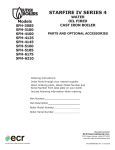
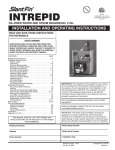
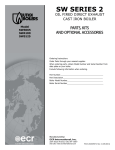
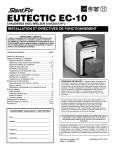

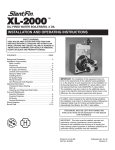
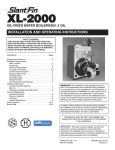
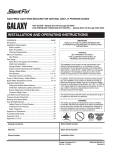
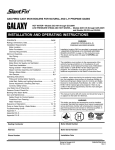
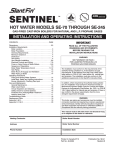
![10780-90006 - 10780A Laser Receiver for 5501A [Prefix 1948] (Mar](http://vs1.manualzilla.com/store/data/006009643_1-6e2f54ebb2199ef6df634558ba4c1bb6-150x150.png)
